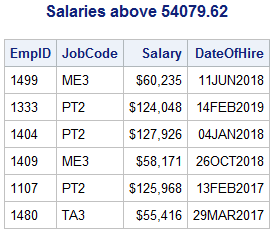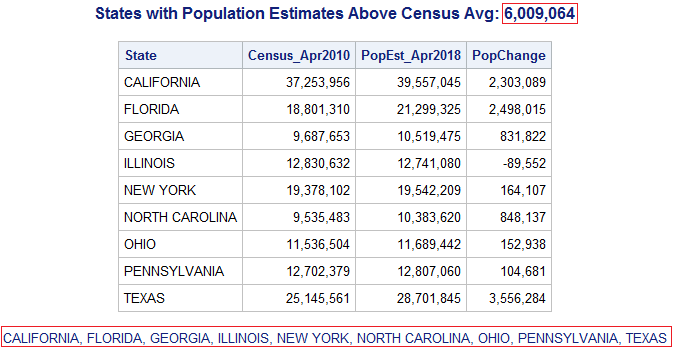Creating Data-Driven Macro Variables with PROC SQL
A SAS macro variable
stores text that is substituted in your code when SAS runs the program.
Macro variable execution is similar to an automatic find-and-replace.
Macro variables are temporary, and they are stored in-memory, so when
you exit SAS, they are deleted. However, you can create data-driven
macro variables with a PROC SQL query and then use those macro variables
in your SAS program, procedure, and DATA step.
Creating Data-Driven Macro Variables with the INTO Clause
The INTO Clause
You can access the macro
facility in a PROC SQL step by using the INTO clause in the SELECT
statement. The various forms of the INTO clause
can perform a variety of functions. For example, you can create a
series of macro variables, a varying number of macro variables, or
a single macro variable that records a value that is the result of
concatenating the unique values of an SQL variable.
The INTO clause in a
SELECT statement enables you to create or update macro variables.
You can create multiple macro variables from query results. If the
macro variable does not exist, INTO creates it. The INTO clause in
the SELECT statement can also assign the result of a query to a macro
variable. However, the INTO clause can be used only in the outer
query of a SELECT statement and not in a subquery. Note that the INTO
clause cannot be used when you are creating a table or a view.
|
Syntax, INTO clause:
PROC SQL <options>;
SELECT column-1 <,...column-n>
INTO: macro-variable-specification-1 <...,
:macro-variable-specification-n>
QUIT;
macro-variable-specification
names one or more macro
variables to create or update. Precede each macro variable name with
a colon (:).
|
Note: When you create or update
macro variables during execution of a PROC SQL step, you might not
want any output to be displayed. The PRINT | NOPRINT option specifies
whether a SELECT statement's results are displayed in output. PRINT
is the default setting.
Tip
Values that are assigned by
the INTO clause use the BEST8. format.Step 1: Create the Macro Variable
Suppose you are asked
to find out which employees who were hired after 01JAN2015 are earning
above the average salary for the company. First, create the macro
variable AvgSal.
proc sql;
select avg(Salary)
into:avgSal
from certadv.payrollmaster;
quit;
The average salary value
is stored in the AvgSal macro variable. If the query produces more
than one row of output, the macro variable contains only the value
from the first row. If the query has no rows in its output, the macro
variable is not modified. If the macro variable does not yet exist,
it is not created.
Step 2: Use the Macro Variable
You can use the macro
variable AvgSal in titles and queries.
title "Salaries above: &AvgSal"; proc sql; select EmpID, JobCode, Salary, DateofHire from certadv.payrollmaster where Salary>&avgSal and DateofHire>'01JAN2015'd; quit;
The query above filters
the data by the value of the AvgSal macro variable. The query returns
rows for all employees earning above the average salary.
Output 6.1 PROC SQL Query Result

Tip
You can format the macro variable
value in the title by using SAS functions and formats. Here is an
example: title "Salaries above: %left(%qsysfunc(putn(&AvgSal,dollar16.)))";Displaying Macro Variable Values
You can use the %PUT statement
to display the resolved macro value in the SAS log. This is a good
debugging technique to ensure that the value is what you expected.
|
Syntax, %PUT statement:
%PUT text;
text
is any text string.
|
Suppose you want to
view the macro variable’s value after you have used the NOPRINT
option. You can use the %PUT statement to view the value.
%put avgsal=&avgSal;
The value of the macro
variable is printed in the SAS log.
Log 6.1 SAS Log
avgSal=54079.62
Tip
You can also enter the following
code %put &=AvgSal; and receive the same
value for the macro variable as above. Removing Leading and Trailing Blanks
When storing a value
in a single macro variable, PROC SQL preserves leading or trailing
blanks. You can remove leading and trailing blanks by using the TRIMMED
option in the INTO clause.
|
Syntax, INTO clause:
PROC SQL <options>;
SELECT column-1 <,...column-n>
INTO: macro-variable-specification-1 <...,
:macro-variable-specification-n> TRIMMED
QUIT;
|
The following example
illustrates the difference between using and not using the TRIMMED
option to remove leading and trailing blanks.
proc sql;
select min(PointsEarned)
into:MinMiles
from certadv.frequentflyers;
quit;
%put &=MinMiles;
The following is printed
to the SAS log.
MINMILES= 146
In HTML output, the
spaces are automatically removed, so extra spaces are not noticeable
there. If your output is sent to the SAS log or is printed in a format
other than HTML, you can still see the leading and trailing blanks.
Output 6.2 PROC SQL Query Result
If you included the
TRIMMED option in the INTO clause, the macro variable is captured
with no leading or trailing blanks.
proc sql;
select min(PointsEarned)
into:MinMiles trimmed
from certadv.frequentflyers;
quit;
%put &=MinMiles;
The following is printed
to the SAS log.
Log 6.2 SAS Log
MINMILES=146
Concatenating Values in Macro Variables
Sometimes, during execution
of a PROC SQL step, you might want to create one macro variable that
holds all values of a certain data set variable. You can use an alternate
form of the INTO clause in order to take the values of a column and
concatenate them into the value of one macro variable. Use the SEPARATED
BY keyword to specify a character to delimit the values into a macro
variable.
|
Syntax, INTO clause:
PROC SQL <options>;
SELECT column-1 <,...column-n>
INTO: macro-variable-1 <...,
:macro-variable-n> SEPARATED
BY “delimiter”
QUIT;
delimiter
is enclosed in quotation
marks and specifies the character that is used as a delimiter in the
value of the macro variable.
|
Note: This form of the INTO clause
removes leading and trailing blanks from each value before performing
the concatenation of values.
Suppose you want to
create a macro variable named Sites that contains the names of all
the training centers in your Certadv.Schedule data set. The names
are separated by blanks.
proc sql noprint;
select distinct location into: sites separated by ' '
from certadv.schedule;
quit;
Now, you can use the
Sites macro variable in the title for your query or procedure result.
title1 "Total Revenue";
title2 "from Course Sites: &sites";
proc means data=certadv.all sum maxdec=0;
var fee;
run;
Output 6.3 PROC MEANS Output

Applying a Format to Character and Numeric Variables
Suppose you have census
data, Certadv.Census. You are asked to create a report that finds
the states where the estimated population for 2018 is greater than
the average census population in April 2010. You are also asked to
find the difference between the census data and the population estimate
for 2018 where the population estimate for 2018 is greater than 10
million.
The following example
creates two different macro variables, CensusAvg2010 and CensusAvg2010_Format.
The CensusAvg2010 macro variable has no format applied to the value
of the macro variable. The CensusAvg2010_Format applies the COMMA16.
format to the value of the macro variable.
proc sql noprint; select avg(Census_Apr2010) as No_Format, avg(Census_Apr2010) as Format format=comma16. into:CensusAvg2010, :CensusAvg2010_Format from certadv.census; quit;
The following example
creates one macro variable, StateList, with the UPCASE23. format applied
to the value of the macro variable. The value of the macro variable
is filtered based on criteria in the WHERE clause and is ordered by
the state name.
proc sql noprint; select State format=$upcase23. as State into:StateList separated by ', ' from certadv.census where PopEst_Apr2018>&CensusAvg2010 and PopEst_Apr2018>10000000 order by State ; quit; %put &=StateList;
The following is printed
to the SAS log.
Log 6.3 SAS Log
ARIZONA, CALIFORNIA, FLORIDA, GEORGIA, ILLINOIS, INDIANA, MARYLAND, MASSACHUSETTS, MICHIGAN, MISSOURI, NEW JERSEY, NEW YORK, NORTH CAROLINA, OHIO, PENNSYLVANIA, TENNESSEE, TEXAS, VIRGINIA, WASHINGTON
The following example
produces a query result using the macro variables created above.
title "States with Population Estimates Above Census Avg: &CensusAvg2010_Format"; footnote "&StateList"; proc sql; select strip(State) format=$upcase23. as State, Census_Apr2010 format=comma12., PopEst_Apr2010 format=comma12., (PopEst_Apr2018-Census_Apr2010) format=comma12. as PopChange from certadv.census where PopEst_Apr2018>&CensusAvg2010 and PopEst_Apr2018>10000000 order by State; quit; title; footnote;
Output 6.4 PROC SQL Query Result

Last updated: October 16, 2019
..................Content has been hidden....................
You can't read the all page of ebook, please click here login for view all page.
